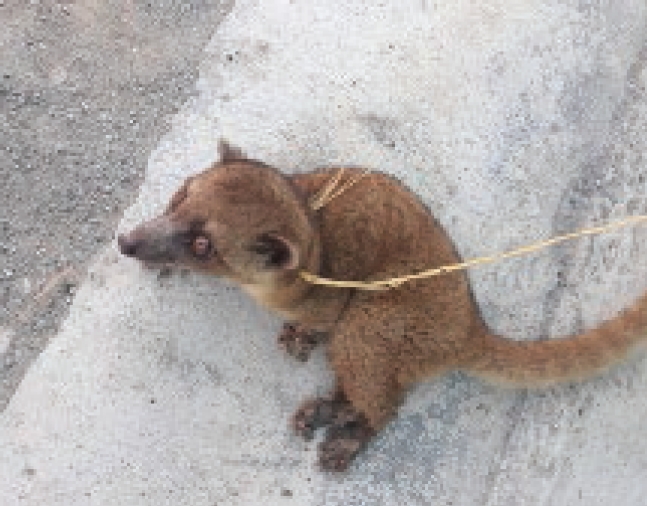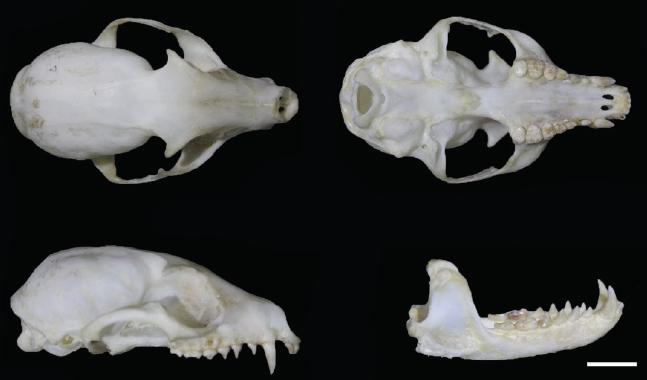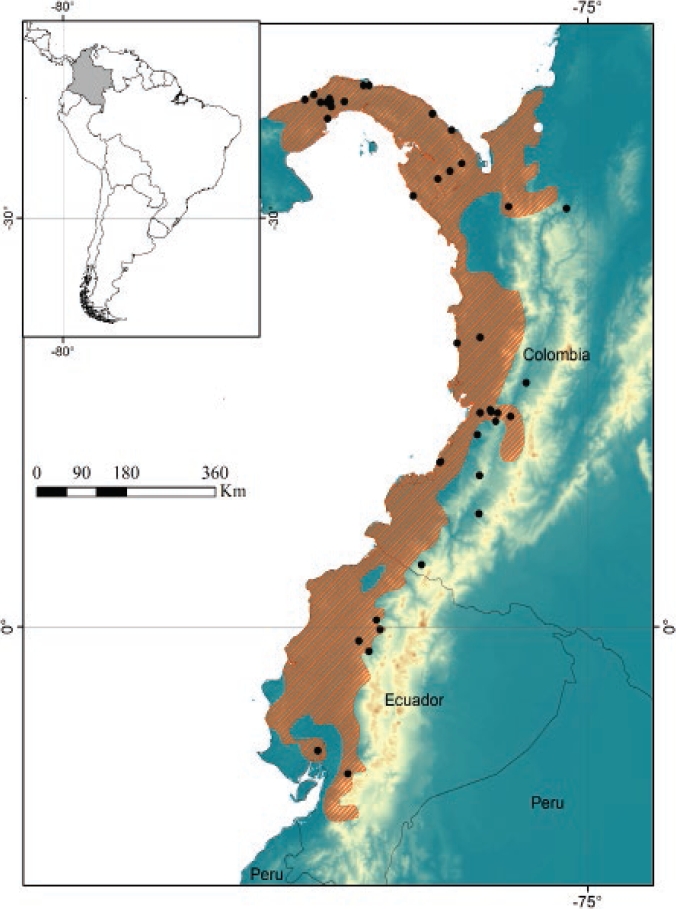Introduction
Procyonids (Procyonidae) are a group of carnivore mammals (Carnivora) from the Americas. Among procyonids, the genus Bassaricyon comprises four species (Helgen et al. 2013) distributed from Central America south to southern Bolivia in South America (Emmons and Feer 1990; González-Maya and Belant 2010), in an elevational range between 0 and 2,750 m. Procyonids live in tropical, subtropical, dry and montane forests (Helgen et al. 2013). Due to their cryptic nature and solitary arboreal habits, field sightings are rare, hence limiting the current knowledge on these species (Reid 1998; Ramirez and Valencia 2007; González-Maya and Belant 2010).
In Colombia, the knowledge of procyonids has increased in recent years, including the number of species reported from seven (Guzmán-Lenis 2004; Solari et al. 2013) to nine (Andrade-Ponce et al. 2016). This increase is based on the record of one recently described species (B. neblina) and the knowledge on the distribution of the genus (Helgen et al. 2013). Before the work of Helgen et al. (2013) that elucidated the richness of this genus in the Neotropic, information on this genus was scarce. Today, three species of Bassaricyon are recorded for Colombia (B. alleni, B. medius and B. neblina), with recent studies on the distribution only for B. neblina and B. alleni (Suárez-Castro and Ramírez-Chaves 2015; Andrade-Ponce et al. 2015, 2016; Cardona et al. 2016; Gerstner et al. 2018).
Bassaricyon medius was described from a single specimen from Jiménez (731 masl elevation) in the Department of Chocó, Colombia (Helgen et al. 2013; Andrade-Ponce et al. 2016). Additional information of this species is limited to few records on distribution and morphology (Thomas 1909; Goldman 1912; Saavedra-Rodríguez and Velandia-Perilla 2011; Helgen et al. 2013; Andrade-Ponce et al. 2016). B. medius is a medium-sized procyonid (total length: 680 to 905 mm) relative to the other species in the genus (Helgen et al. 2013). B. medius resembles B. alleni in pelage, but the latter is characterized by a more uniform coloration from head to tail, with a darker dorsal stripe (Helgen et al. 2013). The nose pigmentation is a feature useful for differentiating the species of Bassaricyon. B. medius has a typically pink nose (although the photographs of live specimens in Helgen et al. 2013 show dark brown colorations), differing from that of B. alleni, which has a darker pigmentation (Helgen et al. 2013). Another distinctive character between species is the size of the fourth lower premolar, typically smaller in B. medius (although the mean values, standard deviation, and ranges in Helgen et al. 2013 do not support relevant differences).
Bassaricyon medius is distributed in Colombia, in the Chocó-Darién, Magdalena, and Cauca biogeographic provinces (Andrade-Ponce et al. 2016), in the Departments of Antioquia, Chocó, Cauca, Nariño, and Valle del Cauca (Saavedra-Rodríguez and Velandia-Perilla 2011; Helgen et al. 2013; Andrade-Ponce et al. 2016), but its presence in the Caribbean Region had not been previously recorded (e. g., Muñoz-S and Hoyos-R 2012; Diaz-Pulido et al. 2014; Racero-Casarrubia et al. 2015). B. medius includes two subspecies: B. m. medius and B. m. orinomus, which differ mainly in body size (total length: 680 to 819 vs. 770 to 905 mm, respectively, Helgen et al. 2013). In this study, we recorded the presence of Bassaricyon medius in the Peri-Caribbean Arid Belt Biogeographical Province, Colombian Caribbean.
Materials and Methods
The new record of B. medius comes from the Colombian Caribbean and it is based on photographs of a single live adult female (Figure 1), and the preserved skull of the same specimen (Figure 2). The photographs supplementing this record (Figure 1) were donated by members of the Urbanización Los Recuerdos community, municipality of Monteria, Department of Córdoba. The specimen was delivered dead, in a state of decomposition, and with all four limbs fractured, to members of the Biodiversidad Unicordoba Research Group. We recorded external measurements (total length, head-body length, tail length, and hindfoot length; Table 1), and only the skull could be rescued, which was deposited in the collection of Zoology at the University of Córdoba (CZUC-M-0246; Figure 2). Based on the photographs of the live specimen (Figure 1), we noted distinctive external characters supporting the taxonomic identification (Helgen et al. 2013). These include a uniform coloration between the tail and the body, lacking a blackish dorsal stripe and the coloration of the nose (dark brown, as it appears in the live specimens in Helgen et al. 2013). To confirm the identification, we also took the following cranial measurements recorded in the revision of the genus (Helgen et al. 2013): condylobasal length (CBL), zygomatic width (ZYG), cranial vault height (BBC), cranial vault width (HBC), upper dental series (MTR), width between canines (CC), greatest width across the postdental palatal shelf (WPP), postdental palate length (LPP), anteroposterior length of the auditory bulla (LAB), and inner dorsoventral diameter of the external auditory meatus (EAM). The localities reported for the species were surveyed in the literature (e. g., Thomas 1909; Goldman 1912; Rivas-Pava et al. 2007; Saavedra-Rodríguez and Velandia-Perilla 2011; Helgen et al. 2013; Andrade-Ponce et al. 2016) and in databases of national and foreign museums.

Figure 1 Adult female of Bassaricyon medius captured by inhabitants of urbanización El Recuerdo, Montería, Córdoba. The specimen was delivered to members of the Biodiversidad Unicórdoba Research Group.

Figure 2 Skull of an adult female Bassaricyon medius (CZUC-M 0246) from the Municipality of Monteria, Department of Córdoba, Colombia. Scale = 15.0 mm.
Table 1 External and cranial measurements (n in bold) of species of Bassaricyon (Helgen et al. 2013). Numbers are mean ± standard deviation, with ranges in parentheses.
| Measurements | CZUC-M-0246 |
B. medius medius n = 12; n = 7 ♀♀ |
B. medius orinomus n = 24; n = 17 ♀♀ |
B. alleni n = 27; n = 17 ♀♀ |
|---|---|---|---|---|
| TL | 860.00 | 754.00 ± 49.70 | 844.00 ± 42.90 | 842.00 ± 50.60 |
| (680.00 - 819.00) | (770.00 - 905.00) | (705.00 - 985.00) | ||
| HB | 400.00 | 362.00 ± 29.50 | 385.00 ± 17.20 | 391.00 ± 29.30 |
| (310.00 - 415.00) | (355.00 - 410.00) | (304.00 - 455.00) | ||
| Tail | 460.00 | 392.00 ± 29.10 | 460.00 ± 33.60 | 450.00 ± 28.80 |
| (350.00 - 435.00) | (400.00 - 520.00) | (401.00 - 530.00) | ||
| HF | 82.00 | 73.00 ± 5.40 | 85.00 ± 3.50 | 81.00 ± 5.80 |
| (58.00 - 79.00) | (77.00 - 92.00) | (70.00 - 92.00) | ||
| Tail/HB | 1.15 | 1.10 ± 0.09 | 1.20 ± 0.08 | 1.15 ± 0.08 |
| (0.97 - 1.24) | (1.04 - 1.35) | (1.00 - 1.30) | ||
| CBL | 82.00 | 75.40 ± 1.65 | 78.80 ± 1.72 | 77.00 ± 2.24 |
| (72.40 - 76.70) | (75.50 - 82.30) | (73.10 - 80.50) | ||
| ZYG | 48.60 | 48.50 ± 1.69 | 51.20 ± 1.98 | 50.20 ± 0.99 |
| (46.50 - 51.00) | (47.40 - 54.00) | (48.60 - 52.20) | ||
| BBC | 34.27 | 34.40 ± 0.41 | 35.00 ± 1.15 | 34.90 ± 0.91 |
| (33.70 - 35.00) | (32.80 - 37.20) | (33.30 - 36.80) | ||
| HBC | 28.25 | 26.80 ± 0.89 | 27.00 ± 0.89 | 26.90 ± 0.63 |
| (26.10 - 28.50) | (25.40 - 28.50) | (26.00 - 28.10) | ||
| MTR | 26.00 | 27.10 ± 0.78 | 28.00 ± 0.77 | 27.30 ± 0.69 |
| (25.60 - 27.90) | (26.40 - 29.10) | (26.10 - 28.50) | ||
| CC | 15.00 | 15.00 ± 0.46 | 16.10 ± 0.71 | 15.90 ± 0.55 |
| (14.50 - 15.80) | (14.60 - 17.20) | (14.80 - 16.80) | ||
| WPP | 9.20 | 10.00 ± 0.57 | 10.30 ± 1.04 | 9.90 ± 0.89 |
| (9.10 - 10.60) | (9.00 - 13.00) | (8.20 - 11.70) | ||
| LPP | 10.90 | 9.80 ± 0.84 | 10.20 ± 1.01 | 10.40 ± 0.67 |
| (8.90 - 11.30) | (8.10 - 11.80) | (8.70 - 11.60) | ||
| LAB | 12.40 | 13.40 ± 0.45 | 14.30 ± 0.73 | 14.40 ± 0.81 |
| (12.60 - 13.90) | (12.80 - 15.20) | (13.00 - 15.60) | ||
| EAM | 3.90 | 3.90 ± 0.34 | 3.90 ± 0.28 | 3.80 ± 0.36 |
| (3.50 - 4.40) | (3.60 - 4.70) | (3.20 - 4.40) |
Results
The new record of B. medius comes from an urban matrix of the municipality of Monteria (Department of Córdoba), at Urbanización Los Recuerdos (8° 43’ 08.1” N, -75° 53’ 23.3” W; 14 masl), next to tropical dry forest patches associated with Sierra Chiquita, and was obtained on 4 November 2017 (Figure 3). Sierra Chiquita is a short range of hills belonging to the foothills of Serrania de San Jerónimo, located in the middle portion of the Sinú river valley, Córdoba. This area has a mean annual rainfall of approximately 1,035 mm, mean annual temperature of 27.1 °C, and mean relative humidity of 84 % (Arteaga 2014). The individual was captured on typical trees of the tropical dry forest biome, within an agricultural system associated with Sierra Chiquita, by members of the community of urbanización El Recuerdo who allegedly intended to market the specimen using social networks.

Figure 3 Confirmed records of Bassaricyon medius. White circle: new record in the Department of Córdoba, Colombia. Black circles: confirmed records. Orange: potential distribution range according to IUCN (Helgen et al. 2016).
Externally, the specimen shows a uniform coloration between the body and the tail, with no evidence of a dark dorsal strip (Figure 1). The nose is dark brown. The external measures are similar to those observed in other species of the genus (Table 1); however, total length and tail length (860.0 and 460.0 mm respectively) exceed the values seen in B. neblina (upper limits: 820.0 and 424.0 mm, respectively). The skull measurements are similar to those recorded for females of other species in the genus found in Colombia (Table 1). However, condylobasal length (82.0 mm) and cranial vault width (28.2 mm) exceed the upper limits observed in B. alleni and B. neblina (80.5 and 28.1 mm for B. alleni, and 77.9 and 27.8 mm for B. neblina).
When we compared the pelage coloration and external and cranial metrics of the specimen CZUC-M-0246 with those reported in the literature (Figures 1, 2; Table 1). We found that they match those reported for B. medius (Helgen et al. 2013). B. medius and B. alleni are closely similar; however, CZUC-M-0246 was identified based on external and cranial traits of B. medius, namely slightly lighter coloration of the dorsal pelage, smaller body size, and wider and shorter rostrum. Based on body size and craniodental characters, mainly condylobasal length (Table 1), this individual was assigned to B. m. orinomus (CBL: 72 to 76.7 mm in B. m. medius vs. 75.5 to 82.3 mm in females of B. m. orinomus).
Discussion
Over the past 10 years, studies on mammals of the Department of Cordoba increased the knowledge of species living in the different subregions across the territory (Racero-Casarrubia et al. 2015). For Procyonidae, only two species (Potos flavus and Procyon cancrivorus) were previously reported in several localities of the Department (Solari et al. 2013; Racero-Casarrubia et al. 2015). Thus, this is the first record of Bassaricyon in Córdoba. The lack of previous records of Bassaricyon in Córdoba may derive from the fact that these procyonids can easily be misidentified with the kinkajou (Potos flavus), which is more common in the Caribbean region of Colombia (Suárez-Castro and Ramírez-Chaves 2015).
This new record of B. medius adds to the localities reported in the literature for is the northern-most known locality of the species in Colombia (Thomas 1909; Goldman 1912; Saavedra-Rodríguez and Velandia-Perilla 2011; Helgen et al. 2013; Andrade-Ponce et al. 2016), which now has records for the Caribbean, Pacific, and Andean regions of Colombia, between an elevational range from 0 to 1,800 masl. The distribution covers the Peri-Caribbean Arid Belt, Chocó-Magdalena, and Nor-Andean biogeographic provinces (sensuHernández Camacho et al. 1992). Records of B. medius in Colombian collections are scarce (Suárez-Castro and Ramírez-Chaves 2015). Only the mammals collections of the Universidad del Valle (UV) and Universidad de Nariño (PSO-Z) have specimens of this species. Records in literature identified as B. gabbi from the Department of Cauca (Rivas-Pava et al. 2007) and other two specimens deposited in the collection of mammals of the Museum of Natural History at Universidad del Cauca (without exact locality), belong to B. neblina. Considering the scarcity of records of B. medius in Colombian collections, nit is worth highlighting the rescue of the skull (CZUC-M-0246) for its deposit in a biological collection.
Finally, although specimens of other procyonids such as Potos flavus and Nasuella olivacea have been reported as pets (Ramírez-Chaves et al. 2008), this use in olingos is documented here for the first time. Apart of the illegal traffic, Bassaricyon are also affected byroad-kills (Delgado-Velez 2014).











 nueva página del texto (beta)
nueva página del texto (beta)


